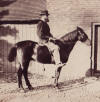
Harriet Wadsworth Harper, was a cousin of Historical Long Rider Martha Wadsworth (below). Unlike other women of her time, Harriet was unusual in that her side-saddle placed her legs on the right-hand side of the horse, not the left-hand side. "The family woke up one day to the fact that I had begun to look like a crooked little gnome. Something was wrong, so off I was sent to a surgeon, who ordered a steel and leather brace for me and suggested that a saddle to go on the right side of the horse should be made. This was to help correct my crooked back. No girls rode astride in those days - it was unthinkable.... I never changed back to riding on the near [left] side," Harriet wrote.
But what sets Harriet apart from other Historical Long Riders was not her saddle. It was the fact that she and Martha are the only American Long Riders in history to have undertaken an equestrian journey together during which both riders used a side-saddle. In May 1907 they made a 1200-mile journey "down through Virginia to West Virginia, up the Ohio River, across Pennsylvania, and home to Genesee, New York. We stayed at farmhouses, in mining camps, any place that had spare beds."
In an interesting historical aside, one of the "pleasant companions" who joined the intrepid side-saddle Long Riders for a brief period was Gutzon Borglum "the sculptor who carved the heads of Presidents Washington, Jefferson, Lincoln and Roosevelt into Mount Rushmore, South Dakota."


A prolific author, and a great friend of Mark Twain, Charles Warner made a witty and perceptive contribution to the world of nineteenth century American literature when he and Twain co-authored “The Gilded Age”, the book that gave the era its name. In 1887 Warner combined his urbane wit with a love of adventure travel when he penned On Horseback in Virginia. Always a keen observer, the roving author set out on horseback to investigate a great, rugged stretch of southern Appalachia. The extended equestrian journey took Warner from Virginia, through North Carolina, and into the remote hills of Tennessee. Additionally, the book contains a second narrative account of Warner’s equestrian adventures in the Old West. This time he saddled up and rode from El Paso, Texas to Mexico City, Mexico. Both tales comprise a book full of meaty descriptions told by one of America’s premier nineteenth century storytellers.

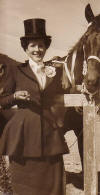
H. H. Weatherly rode a Thoroughbred from Pennsylvania to Ohio in 1909 to demonstrate that this breed of horse “should be distinguished as being more than a mere gambling machine.”
Edwin Lord Weeks occupies a unique position in the pantheon of Long Rider heroes. There are more famous equestrian explorers, more prolific writers. Yet no one ever documented the world of horse travel quite like this Artist-Explorer. Born into a wealthy New England family, Weeks left Boston in the early 1870s in search of artistic training and adventure. He found them both in Paris. The young American studied with the finest artists of his day, developing a style devoted to absolute realism and love of colour. Then, armed with his palette and passport, Weeks set off to paint the dangerous portions of the world. His first daring journey took him to a forbidden section of Morocco in 1878, where he escaped being killed “by the skin of my teeth.” Back in his Paris studio, Weeks produced large paintings depicting the Oriental mystery and glamour he had witnessed in Morocco. With his beautiful paintings now hanging in prestigious Paris salons, the young painter’s fame was assured. Yet it was his equestrian journey from Persia to India that provided Weeks with the material, not only for a superb equestrian travel book, but the magnificent paintings of mythical India which assured him of artistic immortality. Accompanied by the noted travel writer, Theodore Child, the young adventurers set off in 1892 to ride more than a thousand miles from Trebizond to Bushire. During the course of their journey the two friends encountered a bevy of bad lodgings, bandits, and even death. For ultimately only Weeks managed to ride into India, after having lost his companion to the terrors of the trail. Though the brilliant expatriate artist went on to produce some of the most celebrated Indian paintings ever done, his beautifully written account of the equestrian journey which inspired his masterpieces, has been largely forgotten for more than a hundred years. Amply illustrated with drawings done during this historic journey, Artist Explorer recounts the amazing adventures of a painter who sought to study the world and his soul from the back of that ancient altar of travel, the saddle.

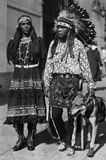
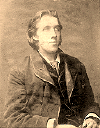
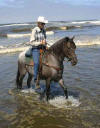
Blame it on the Czar ! If Harry de Windt, that dashing 19th century Long Rider, had been allowed to follow his original plan, he would have galloped to India via the Central Asian satraps of His Imperial Russian Highness. When suspicious St. Petersburg put a halt to Harry’s Russian route, the intrepid equestrian explorer determined to reach his goal via the Shah’s empire instead. What followed was a ride to remember as Harry de Windt, lecturer, author, Fellow of the Royal Geographical Society and equestrian explorer par excellence, saddled up in 1890 and set off to examine the forgotten corners of Persia and Baluchistan. The resultant journey was literally one for the record books as the redoubtable Harry proved time and again that he wasn’t going to be put off by a few minor inconveniences such as the weather, which ranged from an arctic storm in Persia that froze his cigar to his lips, to a howling desert wind in Baluchistan with temperatures nearing 120 degrees Fahrenheit! Neither was handsome Harry bothered by the less than ideal accommodations he discovered. “The floor was crawling with vermin but in Persia one must not be particular,” he casually observed. Nor was our author overly concerned about his physical safety, dismissing the fact that the last foreign traveller who attempted this route had been “waylaid, robbed, tied to a tree, and left to starve.” Though it reads like a mounted Jules Verne novel, A Ride to India
is replete with the author’s scientific observations and appendices, including details from his exact route, “road overgrown, much camel thorn,” to Harry’s “Table of Languages in Baluchistan.” Part science but all adventure, “A Ride to India” takes the reader for a canter across the Persian Empire of a romantic and bygone age. The intrepid de Windt subsequently undertook an even more hair-raising journey - he travelled from Paris to New York by Land!At first glance Theodore Winthrop didn’t look like a hardened equestrian adventurer when he set out to travel across Washington Territory in the early 1850s. The twenty-five-year-old was a recent graduate of Yale and a confirmed East Coast intellectual. Winthrop didn’t let his education handicap him however. Instead he set out to ride horses and canoes across some of the most remote portions of the early United States. The resultant book, Saddle and Canoe, is a vibrant picture of frontier life in the Pacific Northwest and covers the author’s travels along the Straits of Juan De Fuca, on Vancouver Island, across the Naches Pass, and on to The Dalles, in Oregon Territory. Throughout his journey Winthrop spent much of his time among both pioneers and Indians, whose picturesque descriptions are found within the pages of this historic travel account. Never one to hold back his opinions, the Yankee traveller thus regales the reader with personal observations and blunt honesty on a host of topics, people and places.
